Entries in Glacier Hills wind park (4)
11/21/11 Fragmented farmfields in WeEnergies new wind project AND How do you UN-sign on the dotted line? Farmers want out of wind developer's contracts
The photos below were taken by Jim Bembinster. They show how farmfields have been fragmented by wind turbines and access roads in WeEnergie's Columbia County wind project. What they don't show is the compaction of the soil from heavy machinery. Compacted soil affects crop production. Contracts signed by farmers in this project gives WeEnergies the right to site the turbines as they see fit.
CLICK HERE To read about a farmer whose land was leased to WeEnergies for this project and what has happened to his life and his farm since then.
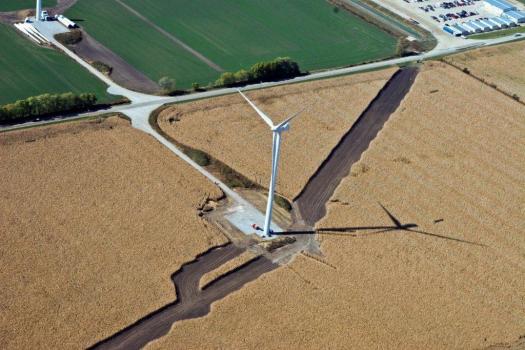
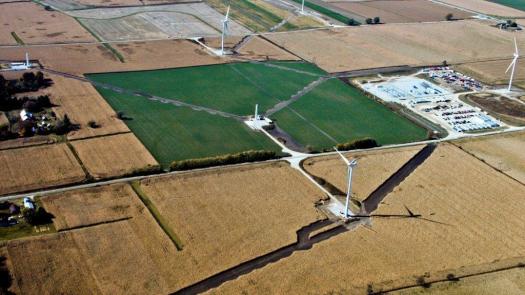
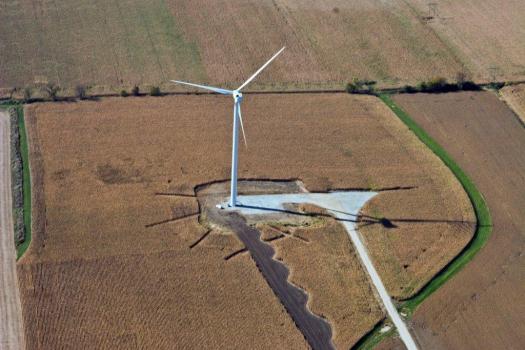
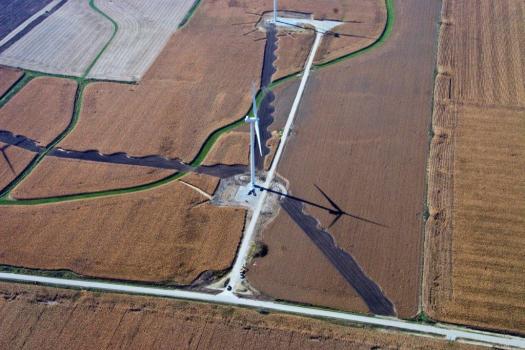
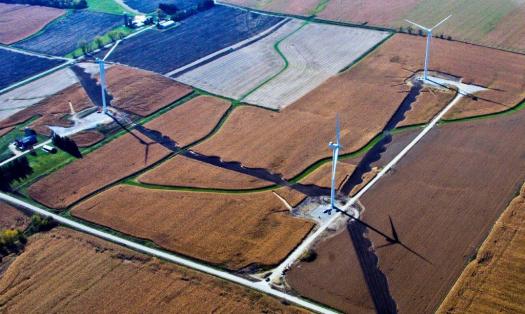
From Minnesota:
SEVERAL LOCAL LANDOWNERS WANT OUT OF WIND CONTRACT
By Regan Carstensen,
SOURCE The Republican Eagle, www.republican-eagle.com
November 21, 2011
“Those landowners a lot of times are making decisions based on what the wind folks are saying,” said Jaime Edwards of the Minnesota Department of Natural Resources. “If they had both sides of the story, they may not have signed the contracts.”
AWA Goodhue Wind has faced many battles in its journey toward getting a permit for a wind farm in Goodhue County, and another one is about to ensue.
A handful of participating landowners who agreed to be part of the 78-megawatt wind farm are now anxious to get out of their contracts and have sent what they call a letter of termination to AWA Goodhue.
AWA Goodhue officials declined to comment.
In addition to a long list of other reasons, the landowners — who asked not to be identified — said realizations about possible effects on the area’s wildlife caused them to want out of the project.
“Those landowners a lot of times are making decisions based on what the wind folks are saying,” said Jaime Edwards of the Minnesota Department of Natural Resources. “If they had both sides of the story, they may not have signed the contracts.”
Mary Hartman, a Rochester resident, has been monitoring the project footprint because she’s concerned about the area’s ecosystem and how it will be affected by more than 45 wind turbines.
Hartman has been in contact with some of the landowners who are looking to void their contracts, and she said she has been helping them see how she thinks a wind farm could be putting migratory birds — especially eagles — in harm’s way.
“The people who signed didn’t necessarily know that they had to be concerned about this,” Hartman said.
She said that the topography of land — including the rolling terrain and proximity to water — within the project footprint is ideal for eagles and allows them to soar on warm wind currents in the valleys. But Hartman is worried the construction of a wind farm might disrupt their usual flight paths.
“When they want to come out of the ridge, if they’re surrounded by wind turbines they’re going to get hit,” she explained.
DNR officials share Hartman’s concerns.
“It’s nice to try to use alternative energy, but we are right on the Mississippi Flyway,” Edwards said. “You really have to look hard at whether something like this should be placed on a flyway.”
Edwards also said that although the project has fewer than 50 turbines planned, once one moves in, she expects more are likely to follow.
“It’s the American way — if one wind turbine is good, then 200 must be better,” she explained. “But is it really?”
Edwards traveled out to and studied the project footprint in order to provide assessments of any potential impacts to the non-game wildlife there.
Hartman also has had her fair share of bird watching in Belle Creek Township, including a time she pointed out eagles’ nests to officials at Westwood Professional Services, a company that AWA Goodhue hired to assess the project’s impacts on the environment.
Westwood’s technical director of environmental services, Ron Peterson, compiled a report in June about observations he made with Hartman in May, and concluded there were many fewer eagles and nests in the area than she had seen.
He reported that of the 12 nests Hartman said she had previously observed, six did not exist, one was abandoned, one was new but in an uncharacteristic location, three had been previously recognized by Westwood and one was a duplicate reference to an already known nest.
During her most recent trip to Belle Creek Township on Wednesday, Hartman said she saw more than 15 bald eagles in the project footprint. And although the likelihood of seeing them is higher now that it is migration season, Edwards of the DNR said the eagles would be hard to miss at other times of the year as well.
“There’s no way that you cannot see eagles in that area. They were all over the place,” Edwards said of the numerous times she’s studied the area.
In addition to the research done by the DNR, U.S. Fish and Wildlife Service has done studies of the project footprint and made recommendations to AWA Goodhue on how to best avoid negative impacts to the birds.
USFWS can’t do much beyond those suggestions.
“We can’t bring enforcement against anybody until there’s a documented take of a migratory bird or an eagle,” Rich Davis of USFWS explained.
Davis said AWA Goodhue has not applied for an incidental take permit. Without the permit, the company could face a significant fine upon the death of an eagle from a wind turbine collision.
“If they are actually prosecuted for that and found guilty of the take from their project, they would not be eligible to pursue (an incidental take) permit in the future,” he said.
Any additional eagle deaths from wind turbines would result in more substantial fines, Davis said.
3/19/10 Special to Columbia County: New questions being asked about the Glacier Hills project.
 Glacier Hills Wind Park easement search angers neighbors
Glacier Hills Wind Park easement search angers neighbors
Neighbors irritated by We Energies’ continued search for Glacier Hills Wind Park easements have won the right to review changes to a project the state approved two months ago.
“If they don’t need easements to build the project, then why are they still bothering nonparticipants?” said Friesland resident Gary Steinich. “We didn’t ask for this fight.”
Steinich and other Columbia County landowners who chose not to negotiate with We Energies to give up land for the estimated $434 million wind farm formed the nonprofit group Neighbors Caring About Neighbors.
That group, responding to the utility’s interest in easements, sought and received intervener status Wednesday with the Public Service Commission of Wisconsin for the project.
As an intervener, the group has access to, can comment on and can request PSC review of any changes We Energies makes to the project. The group’s argument, Steinich said, is the utility should not still be seeking easements if the state approved the project and ruled complete the application for the wind farm.
But We Energies still is deciding if it needs to change its original project plan. The utility intended to build 90 turbines, but the PSC’s January approval established 1,250-foot setbacks from properties, even though We Energies wanted 1,000-foot setbacks.
The utility still wants to build 90 turbines and is seeking easements to establish the quickest connection routes between the turbines, said We Energies spokesman Brian Manthey. He said utility representatives since the PSC approval have approached those landowners who had not agreed to give up land to ask for waivers and easements so We Energies would have more room to connect the turbines with transmission cables.
“We haven’t made a final determination on the number of turbines or where all the interconnects will go,” Manthey said. “We expect to have that information sometime in April.”
Technically, the utility, by approaching landowners, is following the guidelines in the PSC’s approval of the project, said Dan Sage, assistant administrator in the PSC’s gas and energy division. The commission’s approval had 29 conditions, including reducing the number of turbines in some areas and seeking alternate sites for some turbines and transmission lines, he said.
Still, Manthey said, even without the easements, the project can and will proceed.
If that’s the case, Steinich said, the utility should not bother the neighbors.
“Why didn’t they state that they needed these easements in the original application?” he said. “Why didn’t they just build the project?”
According to the group’s intervener request, We Energies’ application to build the wind farm explained the utility “possesses the necessary control of lands required for alternative and preferred turbine sites, cables and roads … via easements and easement and purchase options.”
Manthey said the utility simply wants to make sure it investigates all options for connecting the lines before building the farm. Unless the group’s request delays the project, construction should begin this summer, he said.
The group can accept that inevitability, but the neighbors just want to be left alone, Steinich said.
“Obviously, none of us like the wind farm, but our goal here is not to stop it,” he said. “There’s no contesting of the PSC decision. They made it. We’ll live with it.”
11/28/09 Goliath VS Goliath in a fight over right to site wind farm in rural Wisconsin. With a 1000 foot setback, residents lose either way.
How big are the turbines? Click on the image above. The blades extend another 13 stories above the person who is descending from the hub of the turbine tower. In Wisconsin, industrial turbines 40 stories tall have been sited 1000 feet from homes.
WIND DEVELOPER WANTS STATE TO STEP IN
Green Bay Press-Gazette
28 November 2009
A wind farm developer proposing a large project in Brown County is urging state regulators to reject a similar project by another developer in Columbia County.
Invenergy LLC has unveiled plans for 100 turbines to generate electricity south of Green Bay in the towns of Glenmore, Wrightstown, Morrison and Holland.
Local and state approval is needed before the firm’s Ledge Wind Energy Project can move ahead.
In the meantime, Invenergy is asking state regulators to reject the We Energies’ proposal in Columbia County or approve both projects jointly.
In a filing earlier this week with the state Public Service Commission, Invenergy wrote that We Energies could purchase power from the Ledge Wind Energy Project for less than the cost of building its own wind farm.
The state has disclosed no timetable for deciding either proposal, although the We Energies project is further along in the regulatory review process.
Invenergy’s application to the state indicates that its Brown County wind farm could be in operation by 2011 and would generate enough electricity to power about 40,000 homes.\
OUR WIND FARM RESIDENT QUOTE OF THE DAY: [Click here for source]
“On Saturday or Sunday afternoon people come out here, stay for the afternoon, go home and wonder what the fuss is about. If you’re out here after 11pm you’ll known what we’re complaining about.”
10/19/09 The big "IF": If one of WEPCO's Wisconsin coal plants is retired, the Glacier Hills project will reduce CO2. If not....same circus, same CO2 clowns.
 THE BIG IF
THE BIG IF
Better Plan takes a closer look at some of the expert testimony on the Glacier Hills Docket.
Today's testimony comes from Jerry Mendl who was hired by Clean Wisconsin to evaluate the effectiveness of the Glacier Hills wind farm at reducing greenhouse gas emissions, particularly CO2.
(NOTE: Mr. Mendl served at the Wisconsin Public Service Commission as Director of the Bureau of Environmental and Energy Systems and also as Administrator of the Division of Systems Planning, Environmental Review and Consumer Analysis. Learn more about Mr. Mendl by clicking here)
[download Mr. Mendl's complete testimony by clicking here]
His testimony is frank and full of surprises, the greatest of which is this:
Unless WEPCO fully retires a coal plant, the Glacier Hills wind farm will not reduce Wisconsin's CO2 emissions, and could in fact, increase them. [1] [2] [3] [4][5]
(We were unable to find any indication that WEPCO wishes to completely shut down one of its coal-fired plants, or that they would be obligated by the PSC to do so.)
Other findings from Mr. Mendl's testimony:
WEPCO does not need additional capacity until 2024. Regardless of whether it builds Glacier Hills or other RPS facilities, WEPCO will have excess capacity through 2024 which it intends to sell. Additional capacity clearly is not needed to serve the projected load and reserve margin. [1] [2]
Because WEPCO intends to sell the excess capacity and energy it produces, it is likely that the CO2 emissions will not be reduced from Wisconsin plants. [3]
Unless WEPCO agrees to take a coal-fired plant off line, the net result of building Glacier Hills to comply with Wisconsin RPS requirements and selling the excess capacity will be little to no reduction of CO2 emissions. The Glacier Hills wind farm itself won’t reduce CO2 emissions unless WEPCO retires a coal fired plant. [3]
NOTE FROM THE BPWI RESEARCH NERD: Another surprise in this testimony involves shutting down the Glacier Hills wind turbines in the summer in order to maintain profitability by burning coal instead. On page 18 of the testimony we find this:
Q. Did your analysis raise any concerns that the Commission should consider?
A. Yes. The analysis suggests that particularly in the summer months, when strongly negative LMPs [locational marginal price] can occur, it would be in the economic interest of the wind generator to shut down the wind turbines, which have zero fuel cost and produce no CO2; and instead operate coal plants that incur fuel costs and generate CO2. In essence, the way the MISO market works, free energy with environmental benefits is too expensive!
Q. What can the Commission do about that?
A. A Commission requirement to retire one or more coal units would help mitigate this occurrence.
As far as Better Plan can tell, WEPCO has no intention of retiring a coal-fired plant and every intention of selling the excess energy. This is understandable in terms of a business plan where profit is the goal.
However if reduction of CO2 emmissions in Wisconsin is the goal, our question to the PSC is this:
What is the benefit of the Glacier Hills wind farm in terms of CO2 reduction to our state if WEPCO does not retire a coal plant?
If there is no CO2 benefit and if WEPCO has excess capacity until 2024 without the Glacier Hills wind farm, how can the PSC justify granting a Certificate of Public Need and Convinience?
The PSC is now taking comments on the Glacier Hills EIS. If you'd like to comment on the lack of reliable CO2 reduction from this project , CLICK HERE To review the entire docket for this project CLICK HERE and enter docket number 6630-CE-302.
References from the testimony document: [download complete testimony by clicking here]
[1] P3:1-13. "Reduction in greenhouse gases, including CO2, is an important purpose of the Renewable Portfolio Standard (“RPS”) law that underlies the Glacier Hills proposal. The effectiveness of Glacier Hills project in reducing greenhouse gases can be best ensured if the Commission requires WEPCO (and other utilities in future RPS projects) to plan for corresponding retirements of existing coal capacity.
4. The opportunity to retire excess capacity exists because WEPCO, even without Glacier Hills, does not need additional capacity until 2024 under the updated forecasts that WEPCO witnesses relied upon for their supplemental testimony. When one adds Glacier Hills and additional wind generation to meet WEPCO’s RPS standard of 662 MW by 2015, WEPCO will not need additional capacity until at least 2026. Thus, it is clear that WEPCO could retire at least 100 MW of existing coal generation."
[2] P.5: 2-22 Q: Will the operation of Glacier Hills result in WEPCO having excess capacity?
A. Yes. According to its application in this docket, as amended by WEPCO’s updated forecast and supplemental direct testimony, WEPCO will have excess capacity through 2024, regardless of whether it builds Glacier Hills or other RPS facilities.
Q. Does WEPCO plan to sell excess accredited capacity? A. Yes. Although WEPCO has not identified specific plans, it has indicated that it intends to sell all capacity over the 14.5% reserve margin prior to each planning year. It has done so for 2009.
[3] P.6:17-20 Q:What effect would WEPCO’s planned sale of excess capacity have on the emission of greenhouse gases from WEPCO’s power plants?
A: If WEPCO sells the excess capacity and energy it produces, it is likely that the CO2emissions will not be reduced from Wisconsin plants. WEPCO’s EGEAS runs show a decrease in CO2 emissions to supply electricity used by WEPCO’s customers. However, if the purchaser of the excess capacity takes energy at levels equivalent to or greater than that forecasted by WEPCO for its own loads without Glacier Hills, the net CO2 emissions from WEPCO plants would not be reduced and may be increased.
[4] p.14:1-15 In concept, Wisconsin utilities may install renewable resources to meet the RPS objectives and to reduce greenhouse gases, and MISO could then dispatch the resources available without reducing the utilization of Wisconsin coal-fired power plants. In this example, Wisconsin’s CO2 emissions would stay the same, although MISO dispatch would reduce the utilization of power plants elsewhere in the MISO 5
footprint.
Q. Should that be a concern to this Commission? 7
A. Yes, for at least two reasons. First, if MISO dispatch displaces a highly efficient natural gas fired combined cycle plant with generation from Glacier Hills, the effectiveness at reducing CO2 emissions will be far less than if MISO displaces a relatively inefficient coal-fired unit with much higher CO2 emissions per kWh.
Second, if CO2 emissions by state are ever used as a benchmark of global climate change performance, Wisconsin would be identified as an underperformer because MISO dispatch produced CO2 in Wisconsin plants, even though the energy was consumed elsewhere.
[5] P.18: 8-16 Q. Did your analysis raise any concerns that the Commission should consider?
A. Yes. The analysis suggests that particularly in the summer months, when strongly negative LMPs can occur, it would be in the economic interest of the wind generator to shut down the wind turbines, which have zero fuel cost and produce no CO2; and instead operate coal plants that incur fuel costs and generate CO2. In essence, the way the MISO market works, free energy with environmental benefits is too expensive!
Q. What can the Commission do about that?
A. A Commission requirement to retire one or more coal units would help mitigate this occurrence.